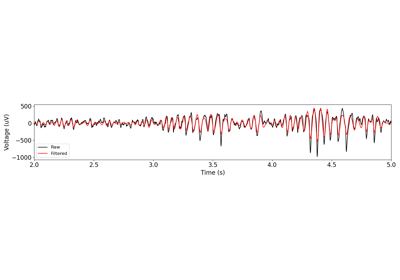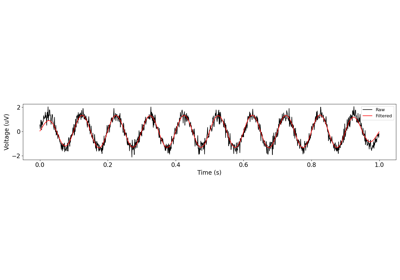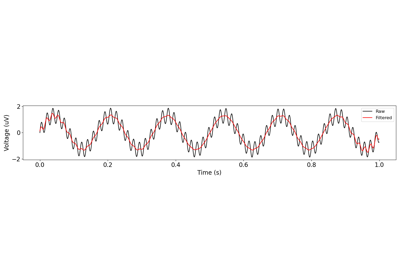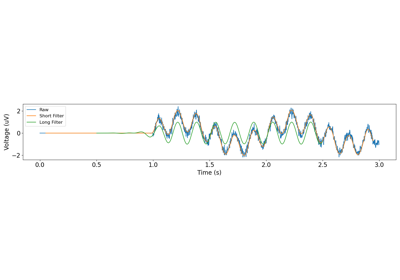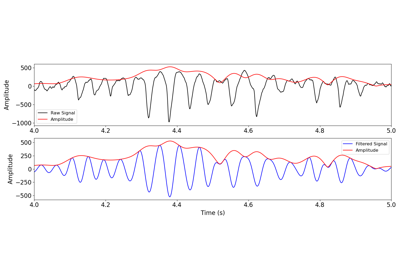neurodsp.filt.filter_signal¶
- neurodsp.filt.filter_signal(sig, fs, pass_type, f_range, filter_type=None, print_transitions=False, plot_properties=False, return_filter=False, **filter_kwargs)[source]¶
Apply a bandpass, bandstop, highpass, or lowpass filter to a neural signal.
- Parameters:
- sigarray
Time series to be filtered.
- fsfloat
Sampling rate, in Hz.
- pass_type{‘bandpass’, ‘bandstop’, ‘lowpass’, ‘highpass’}
Which kind of filter to apply:
‘bandpass’: apply a bandpass filter
‘bandstop’: apply a bandstop (notch) filter
‘lowpass’: apply a lowpass filter
‘highpass’ : apply a highpass filter
- f_rangetuple of (float, float) or float
Cutoff frequency(ies) used for filter, specified as f_lo & f_hi. For ‘bandpass’ & ‘bandstop’, must be a tuple. For ‘lowpass’ or ‘highpass’, can be a float that specifies pass frequency, or can be a tuple and is assumed to be (None, f_hi) for ‘lowpass’, and (f_lo, None) for ‘highpass’.
- filter_type{‘fir’, ‘iir’}, optional
Whether to use an FIR or IIR filter. IIR option is a butterworth filter. If None, type is inferred from input parameters, and/or defaults to FIR.
- print_transitionsbool, optional, default: True
If True, print out the transition and pass bandwidths.
- plot_propertiesbool, optional, default: False
If True, plot the properties of the filter, including frequency response and/or kernel.
- return_filterbool, optional, default: False
If True, return the filter coefficients.
- **filter_kwargs
Additional parameters for the filtering function, specific to filtering type.
For FIR filters, can include:n_cycles : float, optionalFilter length, in number of cycles, defined at ‘f_lo’ frequency.Either n_cycles or n_seconds can be set for the filter length, but not both.If not provided, and n_seconds is also not defined, defaults to 3.n_seconds : float, optionalFilter length, in seconds.Either n_cycles or n_seconds can be set for the filter length, but not both.remove_edges : bool, optional, default: TrueIf True, replace samples within half the kernel length to be np.nan.For IIR filters, can include:butterworth_order : int, optionalOrder of the butterworth filter. See input ‘N’ in scipy.signal.butter.
- Returns:
- sig_filt1d array
Filtered time series.
- kernel1d array or tuple of (1d array, 1d array)
Filter coefficients. Only returned if return_filter is True.
Examples
Apply an FIR band pass filter to a signal, for the range of 1 to 25 Hz:
>>> from neurodsp.sim import sim_combined >>> sig = sim_combined(n_seconds=10, fs=500, ... components={'sim_powerlaw': {}, 'sim_oscillation' : {'freq': 10}}) >>> filt_sig = filter_signal(sig, fs=500, pass_type='bandpass', ... filter_type='fir', f_range=(1, 25))
